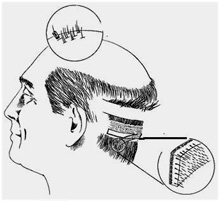
Hair Transplantation
Hair transplantation basically means transferring hair located in the back of the neck which is genetically never-shedding to the problematic area.
Contrary to popular belief, hair transplantation is an operation which began in 1930. Japanese Dr. Okuda did the first hair transplantation. In our country the practice began around the 1980s.
Classification and Areas
Type VII, which can be seen in the classification, is generally the group which is not suitable for hair transplantation. The gap area is too large to be covered with the follicles that are going to be taken from the area called donor area. As type VI can be partially covered, person’s expectations are important deciding about the operation.
Type II-III-IV are generally the group which are suitable for hair transplantation. Type V requires more than one session to cover all the gap area and the transplantation area may be too sparse to fulfill person’s expectations.
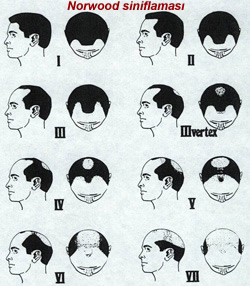

What causes hair loss?
Hair shedding occurs especially between the ages 19-20 and 30-35 depending on following reasons:
- Stress
- Wrong products used in hair care
- Transition from family
- Iron deficiency anemia
- Hyozincemia
- Various illnesses
The most common one among these ishair sheeding seen in males which is transitioned from family called androgenetic alopecia
First Step in Hair Transplantation
The first step in hair transplantation starts with examination of the doctor who is going to carry out the operation.
Donor area ( area where follicles are goingto be taken from) is examined by taking density and quality into consideration with a densitometer so that the size and the follicle denseness of the area that will be covered can be guessed approximately and then this information is shared with the person. If the hair is suitable for transplantation, the person is informed about the sessions and results.
Thanks to the densitometer we can have nearly complete information about the number of follicle number and the number of follicles that are going to be harvested depending on that and the size of the part that is going to be taken from the back of the neck.
Therefore the donor stock which is limited and very precious which can be needed in the future is used efficiently.
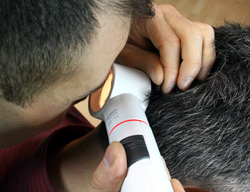
Eschenbach Densitometer which has 38 Dioptry Zoom


Operation Begins
The patient is prepared for the operation by shaving only the part where the hair will be taken. Aafter the operation there is no change in the appearance of the back of the neck.
Local Anesthesia
- Firstly the part where the hair will be taken is locally anaesthetised.
- Operation starts when the patient can no longer feel pain
- Meantime an anesthesiologist is present to ensure the patient is calm and pain-free.
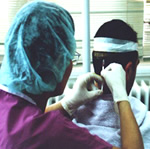
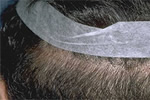
Taking the Follicles Out
After the area is anaesthetised completely, the follicles in the back of the neck area is taken out with a special surgery technique and closed with a hidden cosmetic stitch and the hair is combed.
Preparing the Microgrefts
Microgreft technique is a special tecnique which started to be used in hair transplatation in the recent 4-5 years that aims a natural appearance. The hairs taken are put into groups of 2.3,4 or 5 barbas(single hair) which are called follicular units and seperated into their roots as life units. Approximately in every operation 1.000-3000 follicular units (corresponds to 2.000-9.000 singular barbas) are prepared. This means every follicle transplanted doesn’t have only one singular barba. They are generally in groups of two or three.

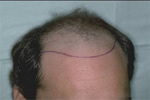
Creating the Natural Hairline
Natural hairline is based on placing the follicles without order and in an assymetrical way in the front area. We can see this assymetric and iregular hair distribution in people who never experienced hair shedding if we look close enough.
Opening the canals
After determining the area where the transplantation is going to be made, the canals where the follicles will be planted are opened. The canals are opened with milimetrically cut and preapred Chisel blades according to the diameter and depth of the follicular units.
For example; while 0.8 to 1mm cut chisel blades are used for front hairline, for the back part 1.1 mm t01.4 mm cut chisel blades are used for increasing hair sized canals opened for 2 to 3 grouped follicles. Thus, the transplant area is less traumatised. Also there will be less crusting and faster healing is ensured after the transplantation.
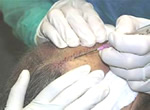

Microgrefts are Placed
Operation ends with the transplantation of the preapared follicles into the canals. In every session 2500-3000 follicles can be transplanted.
After the Hair Transplantation
After the operation it may take up to 3 or 6 months for the new hair to be grow. The hair around the transplantation area will shed after 2 weeks and follicles restart producing hair. It takes around 6 months for all the follicles to finish production.